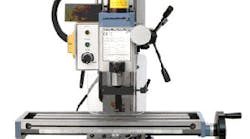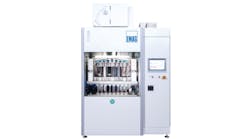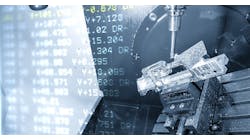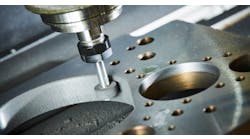The HiTorque 7×12 Deluxe Mini Lathe has digital readouts, metal hand wheels, and chrome levers. Its metal change gears allow a wide range of threading capabilities, and its 21-tooth gear is essential for cutting accurate metric threads.
It’s fine to stroll through McCormick Place and admire the sleek cases and innumerable variants offered by the big machine tool builders: every penny of their R&D and years of experience is visible in the CNC systems and other machinery they develop for ever-more sophisticated shops and OEMs producing high-volume orders. But what about the smaller orders, or the experiments that need to be tested? What options are there for the hobbyist residing in the soul of so many machine shop operators?
LittleMachineShop.com started out 10 years ago because hobbyist Chris Wood couldn’t locate the tooling and parts he needed for his projects. Now the Pasadena, Calif., company is a reliable source of tooling, parts, and accessories “for bench-top machinists,” and since 2009 it has been offering CNC milling machines built to specification by SIEG, and branded as LittleMachineShop.com’s HiTorque line. Not satisfied with machines sold for hobbyists, in 2009 LittleMachineShop.com began selling CNC milling machines, HiTorque mini mills, and HiTorque lathes built to the company’s specifications by SIEG.
A solid-column mill is the newest HiTorque Mini Mill offering from LittleMachineShop.com. The 3960 has a column that’s fixed for greater rigidity and reduced chatter, and to achieve greater accuracy in milling operations. “I’ve had a mini mill for over ten years,” explained Chris Wood, “and I’ve never tilted the column except by mistake.”
For milling at odd angles, Wood recommended instead that operators should tilt the workpiece using a sine vise, tilting table, or other method. LittleMachineShop.com added that discussions with its customers revealed that the tilting capability available on other mini mills is rarely used.
But, the supplier called the new 3960 solid-column mini mill is “the most powerful in its class,” and stated it offers the most low-speed torque thanks to a 500-W brushless DC spindle drive motor. (Most comparable machines have a 350-watt motor. The spindle drive has no gears, so it’s quieter and more convenient to maintain than similar offerings.
The HiTorque Mini Mill (both the solid-column and tilting-column versions) have a mill table that’s 50% percent larger than other mini mills, and the travel 30% greater in each direction, meaning the work envelope is significantly larger.
Also new is a third model of LittleMachineShop.com’s HiTorque lathes — a “deluxe” version of the 7×12 Mini Lathe, with a digital readout (DRO) on the compound rest and one on the cross slide for precision positioning. All the change gears used for lathe threading are durable metal, not plastic, and the machine is trimmed out with brushed metal hand wheels and polished chrome levers.
Like the original HiTorque 7×12 Mini Lathe (and the 3960 mini mill), the new model 4200 mini lathe is described as “the most powerful in its class,” with a 500-watt brushless DC spindle drive motor providing low-speed torque. Most competing brands have only a 250-watt motor. There are no gears to shift, so operators can vary the speed from 50 to 2,500 RPM, continuously, in both directions.
All the HiTorque mini lathes have a longer distance between centers (12.2 in.) than most currently available mini lathes, and have a cam-lock tailstock as standard equipment. They work with all standard American threads (4 to 80 threads per inch), and with the 21-tooth change gear that’s provided they will handle all standard metric threads from 0.3 to 8 mm pitch.






